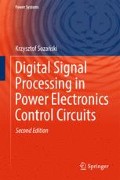Abstract
Selected aspects of the simulation of the power electronics circuit are considered in this Chapter. Special attention is paid to the simulation of power electronics circuits per se and power electronics circuits together with digital control circuits. The presented methods are accompanied by simulations using MATLAB® and PSIM. As an example using PSIM, the three-phase shunt active power filter with three-level inverter is used. For PSIM the considered methods use C source for describing the digital control algorithm. Therefore, it is possible to avoid some limitations associated with the use of defined blocks. Using C code for the realization of the digital control algorithm the user can implement more sophisticated control algorithms. Also considered are PSIMs Hardware Target Modules (e.g., TI F2833x series DSP), together with the SimCoder Module, which provide the capability to automatically generate C code that is ready to run on target specific DSP hardware. The considered simulation methods are illustrated by copious examples.
Access this chapter
Tax calculation will be finalised at checkout
Purchases are for personal use only
References
Ari N (2009) Symbolic computation techniques for electromagnetics: with MAXIMA and MAPLE. LAP Lambert Academic Publishing, Saarbrücken
Attia JO (1999) Electronics and circuit analysis using Matlab. CRC Press, Boca Raton
Blajberg F, Ionel DM (2017) Renewable energy devices and systems with simulations in Matlab and ANSYS. CRC Press, Boca Raton
Cohen JS (2002) Computer algebra and symbolic computation: elementary algorithms. AK Peters/CRC Press, Boca Raton
Cohen JS (2003) Computer algebra and symbolic computation: mathematical methods. AK Peters/CRC Press, Boca Raton
Conrad WR (1995) Solving RL and RC circuits using Matlab. In: Proceedings of American Society for Engineering Education, annual conference proceedings
Getreuer P (2009) Writing fast Matlab code. matopt.pdf. http://www.getreuer.info
Gecko-Simulations (2017). http://www.gecko-simulations.com/index.html
GNU Octave. https://www.gnu.org/software/octave/
IEEE (2017) List of IEEE milestones. http://ethw.org/Milestones:List_of_IEEE_Milestones
Irwin JD, Nelms RM (2015) Basic engineering circuit analysis, 11th edn. Wiley, Hoboken
Jain A (2010) Power electronics: devices, circuits and Matlab simulations. Penram International Publishing, Mumbai
Karris ST (2003) Circuit analysis II with Matlab applications. Orchard Publications, Fremont
Lonngren KE, Savov SV, Jost RJ (2007) Fundamentals of electromagnetics with MATLAB, 2nd edn. SciTech Publishing Inc, Raleigh
LTspice (2017) Linear technology. http://www.linear.com/designtools/software/
Magma (2017) Magma. Computational Algebra Group. http://magma.maths.usyd.edu.au/magma/
Mohan N (1999) Power electronics: computer simulation, analysis, and education using PSpice schematics. Minnesota Power Electronics Research and Education, Minneapolis
Maplesoft (2017) Maple. Maplesoft. http://www.maplesoft.com/solutions/education/
Mathematica (2017) Mathematica. Wolfram Research. https://www.wolfram.com/mathematica/
Mathcad (2017). http://www.ptc.com/engineering-math-software/mathcad
Matlab (2016) Simulink user’s guide. Matlab&Simulink 2016b. MathWorks
Matlab (2017) Matlab documentation. MathWorks. http://www.mathworks.com
Matlab (2017) Matlab file exchange. http://www.mathworks.com/matlabcentral/fileexchange/
Matlab (2017) MATLAB and Simulink based books. https://www.mathworks.com/support/books.html
Patil M, Rodey P (2015) Control systems for power electronics: a practical guide. Springer, New Delhi
Powersys (2004) Tutorial. PSIM simulation software, Powersys Inc., How to use the DLL block
Powersys (2016) PSIM user’s guide. Version 11.0. Powersys Inc.
Powersys (2016) Tutorial. Powersys Inc., How to use general DLL block
Powersys (2016) SPICE module user’s guide. Version 11.0. Powersys Inc.
Powersys (2016) SimCoder user’s guide. Version 11.0. Powersys Inc.
Powersys (2016) DSP development board user’s manual. Version 11.0. Powersys Inc.
Powersys (2016) Tutorial. Powersys Inc., Auto code generation for F2833X target
Powersys (2017). https://powersimtech.com/products/psim/
Pspice (2017). http://www.pspice.com/
SageMath (2017). http://www.sagemath.org/index.html
Scilab (2017). http://www.scilab.org/scilab/about
Small DB, Hosack JM (1991) Exploration in calculus with a computer algebra system. McGraw-Hill College, New York
Szczesny R (1999) Computer simulation of power electronic systems. Wydawnictwa Politechniki Gdaskiej (in Polish)
Shaffer R (2006) Fundamentals of power electronics with Matlab. Charles River Media, Independence
Shenkman AL (2005) Transient analysis of electric power circuits handbook, Springer, Boston
Sobierajski M, Labuzek M (2005) Programming in Matlab for electrical engineering. Oficyna Wydawnicza Politechniki Wroclawskiej, Wroclaw (in Polish)
Sozaski K (1998) Zastosowanie programu Matlab w elektrotechnice. In: Stryjski R (ed) Magnucki K. Wybrane metody komputerowe stosowane w technice. WSP, Zielona Gra (in Polish)
SPICE (2017). http://bwrcs.eecs.berkeley.edu/Classes/IcBook/SPICE/
Sturm RD, Kirk DE (2000) Contemporary linear systems using Matlab. Brooks/Cole Publishing Company, Pacific Grove
SymPy (2017). http://www.sympy.org/en/index.html
TINA (2017) DesignSoft. https://www.tina.com/
Author information
Authors and Affiliations
Corresponding author
Rights and permissions
Copyright information
© 2017 Springer-Verlag London Ltd.
About this chapter
Cite this chapter
Sozański, K. (2017). Selected Simulation Methods and Programs for Power Electronics Circuits. In: Digital Signal Processing in Power Electronics Control Circuits. Power Systems. Springer, London. https://doi.org/10.1007/978-1-4471-7332-8_4
Download citation
DOI: https://doi.org/10.1007/978-1-4471-7332-8_4
Published:
Publisher Name: Springer, London
Print ISBN: 978-1-4471-7331-1
Online ISBN: 978-1-4471-7332-8
eBook Packages: EnergyEnergy (R0)

